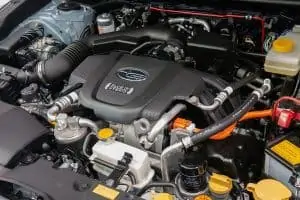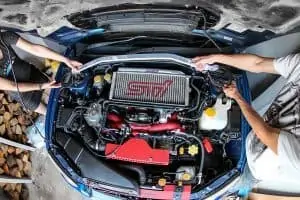Subaru Head Gasket Problems – Is the Bad Rap Deserved?
Subaru’s reputation precedes it when it comes to reliability, and rightfully so. It is one of the most reliable auto brands in the industry, known for its abundance of safety features, consistent reliability ratings and accolades praising it for its commitment to 
If you’re shopping for a new or used car and Subaru is at the top of your list, we don’t blame you, but you should read on to learn more about Subaru’s head gasket issues, especially if you’re looking at purchasing an older model. We’ll look into issues Subaru owners have experienced and what models have been affected to help you make a wise buying decision.
If you are considering buying a used car that has under 140,000 miles and is a 2012 model or newer, get a free quote for one of our "extended car warranty solutions".
100% Online, 9 Coverage Options and No Robocalls!
What is a Head Gasket? What Does it Do?
Do you hear the term “head gasket” mentioned, but not sure quite what it is? And then many times you’ll hear it referred to in relation to a vehicle’s engine, so that may lead to some confusion too for those who may not be as familiar with the inner workings of a vehicle as others. Hopefully, this skinnied down explanation will help.
While the head gasket is different from the engine, they are related, in that the engine relies on the head gasket to keep it running. Most engines are made up of two components, the engine block and the cylinder head. These two parts must seal to one another in order to work as one piece, otherwise the engine will fail. If you think about the sealing function that must occur, that is facilitated by the head gasket. The head gasket is the sealing layer that is sandwiched between the cylinder head and the engine block. When the head gasket is properly tightened, the cylinder head will crush the head gasket into the cylinder block, causing any imperfections to be sealed by force.
Just as the engine is needed to keep a vehicle running, the head gasket is needed to keep the engine working.
Subaru Head Gasket Issues
Subaru vehicles have experienced head gasket issues and you hear about it often enough that anyone shopping for a Subaru is surely to stumble upon information pertaining to Subaru’s faulty head gaskets.
While it is true, there have been head gasket failures on many Subarus, it is important to note that the issues do not apply to ALL Subaru models. Unfortunately the Subaru 
Subaru Head Gasket Problem Years – First Round
The first group is specific to the 1st gen EJ25D 2.5 liter engine found mainly in the Legacy, Legacy Outback, Forester and the Impreza from 1996 to 1999. These engines suffered from internal head gasket leaks. The main reason they experienced issues is because the engine overheated as a result of losing coolant due to the head gasket leak. This leaking coolant resulted in the coolant system not properly working. If the cooling system is not properly working it can’t properly regulate the amount of heat in the engine, which will then lead to an overheated engine. Some of the symptoms seen with this leak are an oily residue found in the coolant overflow bottle and a possible exhaust, fuel or sulphur smell in the overflow coolant bottle. Some other symptoms are higher than normal coolant temperature gauge readings, and intermittent overheating during long trips. In some severe cases you may even experience a cracked radiator. Below are the models that were outfitted with the EJ25D 2.5 engine and may likely experience this head gasket leak.
- Legacy LSi, GT and Outback 1996 – 1999
- Impreza 1998
- Forester 1998
Subaru Head Gasket Problem Years – Second Round
The second group of head gasket issues came with the EJ251, EJ252 and EJ253 2.5 liter engines. These head gaskets suffered from external leaks between the cylinder heads and the engine block causing coolant and/or oil to leak out between the head and the block. This head gasket failure does not typically cause the engine to overheat. However, because of the way the engine and coolant system are situated there could be issues with coolant mixing with the oil. When coolant gets mixed with your oil, it dilutes the oil and hinders the lubrication, making it easier to tear up some other parts like a rod bearing or possibly cause your engine to seize your engine. While these are severe instances, it is possible, so getting that head gasket leak addressed should not be put off. Models affected were those with these specific engines and include model:
- Impreza 1998 – 2003
- Forester 1999 – 2004
- Legacy 1999 – 2004
- Outback 2000 – 2004
- Baja 2003 – 2005
The Subaru Head Gasket Fix and Why the Head Gaskets are Failing
While it makes reasonable sense to point the finger at the engine, specifically the boxer engines, there is research that shows that the issues stem purely from a faulty head gasket. The way the head gasket was made is the root cause of the leaking issues. Subaru had been using a multi layer steel head gasket (MLS head gasket) in the past, and when these engines were introduced into these models mentioned above, they switched the actual head gasket to one that is a single layer gasket with a graphite coating. This graphite coating has been known to chip, strip and peel off at around 100k miles. When the coating strips off, it is no longer able to seal appropriately, hence resulting in a leak. Coolant is going to leak, oil is going to leak, and sometimes both will leak. These graphite coated gaskets are the problem and what has caused the head gasket failures.
Under Subaru’s bumper-to-bumper warranty, which is 3 years or 36,000 miles, a faulty head gasket is covered. But these head gaskets are known to last about 100,000 miles, which is well beyond the 36,000 mark. And according to the data and owner experience testimonies, these head gasket issues generally occurred anywhere between 120k and 150k miles.
Subaru is aware of the head gasket issues and in 2014 began outfitting all their models with different head gaskets that have rectified the issue.
Pro-Tip: Before your factory warranty expires, it’s a good idea to have your Subaru completely checked out to ensure everything is working the way it should. If an issue is discovered, you can have it resolved prior to the OEM expiration date while you’re still covered.
If you own an older Subaru or considering an older Subaru, we recommend investing in an extended warranty to give you peace of mind in the event of an unfortunate breakdown or repair is needed. Extended warranties for older and used Subaru vehicles are available at https://olive.com/.
Cost to Fix a Subaru Head Gasket
As you would expect, fixing a blown head gasket is quite expensive because the labor required is intensive requiring the engine and cylinder blocks to be pulled apart to get to the gasket. The average cost to replace a head gasket is about $1,000, but can range anywhere from $1,200 to $1,400.
If you opt to DIY, it is recommended that you use a Subaru MLS gasket, otherwise known as a multi layer steel gasket. These MLS gaskets do not have a coating on them – no coating, no leaks.
An aftermarket head gasket is not recommended. We understand that some may be 
Regardless of whether you decide to tackle the fix yourself or take it to the dealer, you’ll want to request that a MLS head gasket is used. As of 2014, MLS head gaskets are being used, but it doesn’t hurt to double check.
Pro Tip: The head gasket model number for the faulty head gasket is 11044A6433 and should be avoided.
Signs of a failing head gasket
Here are telltale signs that your head gasket may need to be looked at:
Overheated Engine – If your Subie is running hot or the temperature gauge is reading higher than normal, then you may have a cracked head gasket. If your engine is overheating, stop driving. If you continue to drive on an overheated engine, your head gaskets could be stressed to the point of breaking.
Contaminated Oil – A milky white sludge is a sign that coolant and oil have mixed, resulting in contaminated oil. If you notice this, take your car in to be looked at immediately otherwise run the risk of causing more damage than just the head gasket.
Exhaust Smoke – White smoke or sweet smelling smoke coming from your exhaust means that your coolant is leaking into the cylinders and being turned into steam while your engine is working.
Reduced Engine Power – The head gasket seals in the pressure used for combustion in the engine, so when a head gasket is cracked, the engine will lose power.
Visible Leaks – Leaks outside of the engine of coolant and/or oil is another telltale sign of a head gasket issue. If the engine or coolant gets too low, it can cause serious damage to the engine.
Things You Can do to Prevent Head Gasket Failure
Head gaskets should last about 200,000 miles and preventive maintenance on your Subaru is very important in keeping your Subaru safe and on the road for a long time. Below are some things you can do to prevent premature head gasket failure.
Do preventative maintenance – We can’t overstate this enough. Preventive maintenance is very important and key in identifying things that may become an issue. Don’t skip any preventive maintenance. Checking out your Subie regularly will alert you to any possible items you need to keep a watchful eye over.
Replace your coolant on time – If not changed regularly, the coolant can become corrosive and deteriorate seals and gaskets over time. Using antifreeze is also recommended by Subaru, as well as a coolant additive for Subarus with the second gen engines. Make sure your mechanic inspects the coolant lines, checks the color of your fluid, and of course, that the coolant is topped off.
Change your engine oil on a regular basis – Our cars do not combust 100% of the oil, so any oil that is left over (unburnt) can get into the crankcase where it may mix with the engine oil. The longer this oil is left in the engine, the more diluted it will become and eventually eat away at the seals and gaskets.
Take care of your battery – Make sure your battery is clean and changed out regularly. If you notice any corrosion on the actual batteries, your battery needs to be cleaned. Batteries are meant to last 3 to 5 years, after that they can vent out big amounts of acid.
Avoid non-OE parts – Factory parts are used specifically to maximize your vehicle’s life and performance. Saving dollars on non-OE parts and fluids may cost you more money in the long run. For instance non-OE spark plugs can cause either too hot or too cool combustion temps, which will result in how much your heads and gaskets expand.
Know your Warranty Timeframe – If your Subaru is still under warranty make sure to have it fully checked out by a certified Subaru specialist before the warranty expires to make sure there isn’t an issue that could be covered by the warranty.
We hope you found this information useful and helped to clarify some of the information regarding Subaru’s head gasket issues. There are indeed issues with specific models and because the head gasket issues seem to occur between 120,000 and 150,000 miles, that may be the reason we may be hearing more about them recently.
Subaru is a reliable auto manufacturer and has produced many models that have tremendous reliability records to prove it. If you’re in the market for a Subaru, we recommend doing your own research so that you are in the best position to ask informed questions before making your final purchasing decision. Research the model you’re interested in and look into the warranty that is being offered with it if it is brand new. If it is not brand new, then research olive’s Subaru extended warranty solutions too.
Covering Olive® It
Having to deal with a major repair is no fun. Protect your Subaru with an extended warranty to give you peace of mind and protect you in the unfortunate event of a breakdown. An extended warranty for your Subaru can be an investment worth its weight in gold, especially if you encounter an unexpected repair or breakdown. Protect your ride with olive® at https://olive.com/.
Our olive® Complete Care protection plan not only pays for the covered components, but it pays for the labor and the couplings, seals, gaskets, linkages, and control valves (just to name a few). Now that’s coverage superior to an extended auto warranty!
olive® offers Mechanical Breakdown Insurance plans in case of an unfortunate breakdown. Get a quote online today and be covered tomorrow. Here are some of the benefits you can look forward to:
No waiting period
Start coverage up to 140,000 miles
No yearly mileage limits
Coverage across the U.S.
Low monthly payment options
Cancel anytime
Our products, customer service and reputation for excellence have earned us an A+ rating with the Better Business Bureau, and we have partnered with some of the insurance industry’s largest companies to back us.




